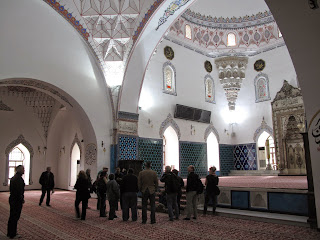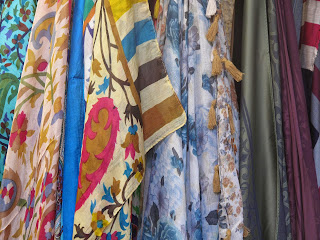Last
weekend, Friday through Sunday, we enjoyed the Ramazan Bayramı, the holiday
marking the end of Ramadan (Ramazan, in Turkish). Although I am not Muslim, I happily greet
Muslim holidays in the spirit they are celebrated, with joy, peace, and renewed
solidarity with friends and family, and rejoicing in the divine. Friday our university
campus was totally quiet, not a soul in sight. Midday I went out for an hour’s
walk, from the main campus beyond the Music Faculty to the east campus and
back. I delighted in the trees, bushes,
and flowers, flourishing thanks to an exceptionally rainy June; the clear view
on this sunny day toward the heart of Ankara and the mountains beyond; and the wonderful
silence.
Mmmm -- Ramazan bread (pide) -- but now we'll have to wait til next year
Friday our university
campus was totally quiet, not a soul in sight. Midday I went out for an hour’s
walk, from the main campus beyond the Music Faculty to the east campus and
back. I delighted in the trees, bushes,
and flowers, flourishing thanks to an exceptionally rainy June; the clear view
on this sunny day toward the heart of Ankara and the mountains beyond; and the wonderful
silence.
The calm was shattered Monday, July 20,
with an explosion in Suruç, a town near the Syrian border, in which over 30
people were killed and more than 100 injured. The dead included Turkish university students
heading across the border to help reconstruction efforts in Kobane, a Kurdish-held
Syrian town severely damaged in an attack from ISIL. The perpetrator has been identified as a
suicide bomber, a young Turkish man, perhaps a recruit from ISIL. This tragic event has shocked the country,
and perturbed the political discourse at a time when the AK Party, the largest
in Parliament, is seeking to form a coalition government. How could this happen? Security lapses? Who is responsible? Have the government’s policies toward Syria
and toward the Kurds been as wise, far-sighted, and effective as the government
has been telling us? Is the country
being adequately protected? What next?? Accusations are flying back and forth, and the
public is concerned.
Westward Ho!
View from the ancient city of Assos (Turkey) toward the island of
Lesbos / Mytilini (Greece)
At the same time, hundreds, thousands
of Syrian, Afghani, and other refugees are crossing Turkey aiming for
Europe. Greece is the first destination,
for the islands offshore from the Anatolian coast are so close. Friends with a summer house near Behramkale,
ancient Assos, recount how every day men, women, and children set off in rubber
boats from their nearby beach to cross to Lesbos (Mytilini), the large Greek
island only 5.5 km distant. Turkish, Greek, and German boats watch but don’t
intervene. People smugglers are making lots
of money.
Link to a short video from the New York Times:
http://www.nytimes.com/video/world/europe/100000003757489/migrants-overwhelm-island-of-lesbos.html
Roman aqueduct on Lesbos
Once on Lesbos, the ordeal only continues. Locals resent their presence. The refugees must make their way (even on
foot) to the island’s main city, be registered, then take a ship for Athens for
the next step in their journey.
Tranquil harbor, Lesbos (north shore)
Most
wish to end up in Germany, thinking the economy will absorb them. Why don’t they try to make a go of it in
Turkey, where the culture is similar, the religion the same? Germany and France are not large melting pots
like the US; in these countries, outsiders have trouble integrating. The more newcomers that arrive, the greater
the tensions. Peace in Syria, Iraq,
Afghanistan, and Africa would be an answer, but who has solutions for that? It’s a cruel, sad dilemma.

Another death came earlier, but this was
not a surprise. Süleyman Demirel (above) passed away on June 17th, age 90, and was laid to rest after
a state funeral. Six times prime
minister of Turkey, then president (1993-2000), Demirel was a dominant
politician from the mid-1960s on. For
all that, I can’t say his legacy was extraordinary. He was trained as a hydraulic engineer, and
it is in dams and other big public construction projects that he made his
mark. For larger political concerns,
such as human rights, international relations, Turkey in the European Union, he
was more reactive than proactive. His
great strength, as far as I can tell, was his ability to relate to people. His nickname was “Baba” (“father”) and he
made a virtue of his small-town origins near Isparta. He made people feel comfortable, whether addressing
crowds (waving his trademark fedora hat) or in one-on-one meetings. I met him only once, at a reception at the
Çankaya Palace, during his term as president, at which İhsan Doğramacı, the
founder of Bilkent University, was presented with a medal. I went through the receiving line; as we shook
hands, Demirel gave me a piercing look.
With total concentration on me as an individual, he was surely asking
himself, “Who is this man? Should I know
him?” Others would have perfunctorily
greeted me, but I now understand this focused interest in everyone, absolutely
everyone, was his great talent. Whether
it led to great things for the country, that’s another matter.

Guests gather in the Lydian garden (Sardis)
The same week, Marie-Henriette and I went
to Sardis for a commemoration of the late excavation director, Crawford H.
Greenewalt, Jr. Some 30 members of
Greenie’s family and numerous archaeologist friends came for the unveiling of a
monument in his honor, a small stele in the ancient Athenian manner, in the
informal “Lydian garden” adjacent to the excavation house.
The next day, excursions. Family and friends climbed the acropolis, a
sharp, eroded peak that dominates the hilly landscape.
Although I had visited
Sardis several times, I had never had the opportunity to do this, so up I, too,
climbed. The top is occupied by a ruined
fortress of early Byzantine times. Much spolia was used in the construction,
pieces from earlier Roman buildings that were recycled here. The effort to
carry up the blocks and other materials and to construct the fort in this
dizzying setting must have been considerable.
Nicholas Cahill, the current
Sardis excavations director, told me that this fort has never been fully
studied. What a great research project this would be! But you would need solid thighs for the lengthy
walk up and down each day, not to mention nerves of steel and complete immunity
from acrophobia in order to record the precariously positioned walls.
Temple of Artemis with platform set up for the musicians
That evening family, archaeologists,
and the public at large were treated to a concert at the edge of the ruined
Temple of Artemis. The featured works were the “Sardis Symphony” and arias from
an opera, “The Judgment of Midas,” both composed by Kamran İnce, a
Turkish-American based in the US. The
Bilkent Symphony Orchestra, from my university, performed, with Kamran İnce
himself as conductor.
Musicians wait before the concert
The setting was
magical, with the temple’s two standing columns and the acropolis as the
backdrop.
The audience, too, waits for the concert
In the balmy evening air, as sunlight gradually gave way to night,
listening to Handel and Bach (arranged by Respighi) in addition to İnce’s
pieces, the audience was transported. Afterward, as I walked back to the
excavation house together with two of the musicians, one said to me, “I have
seen the great temple at Didyma, but this place is truly enchanting
(“büyülücü).” I wholeheartedly agreed.































